Gengyan Li
ETH Zurich, Google
TeGA: Texture Space Gaussian Avatars for High-Resolution Dynamic Head Modeling
May 08, 2025Abstract:Sparse volumetric reconstruction and rendering via 3D Gaussian splatting have recently enabled animatable 3D head avatars that are rendered under arbitrary viewpoints with impressive photorealism. Today, such photoreal avatars are seen as a key component in emerging applications in telepresence, extended reality, and entertainment. Building a photoreal avatar requires estimating the complex non-rigid motion of different facial components as seen in input video images; due to inaccurate motion estimation, animatable models typically present a loss of fidelity and detail when compared to their non-animatable counterparts, built from an individual facial expression. Also, recent state-of-the-art models are often affected by memory limitations that reduce the number of 3D Gaussians used for modeling, leading to lower detail and quality. To address these problems, we present a new high-detail 3D head avatar model that improves upon the state of the art, largely increasing the number of 3D Gaussians and modeling quality for rendering at 4K resolution. Our high-quality model is reconstructed from multiview input video and builds on top of a mesh-based 3D morphable model, which provides a coarse deformation layer for the head. Photoreal appearance is modelled by 3D Gaussians embedded within the continuous UVD tangent space of this mesh, allowing for more effective densification where most needed. Additionally, these Gaussians are warped by a novel UVD deformation field to capture subtle, localized motion. Our key contribution is the novel deformable Gaussian encoding and overall fitting procedure that allows our head model to preserve appearance detail, while capturing facial motion and other transient high-frequency features such as skin wrinkling.
Cafca: High-quality Novel View Synthesis of Expressive Faces from Casual Few-shot Captures
Oct 01, 2024


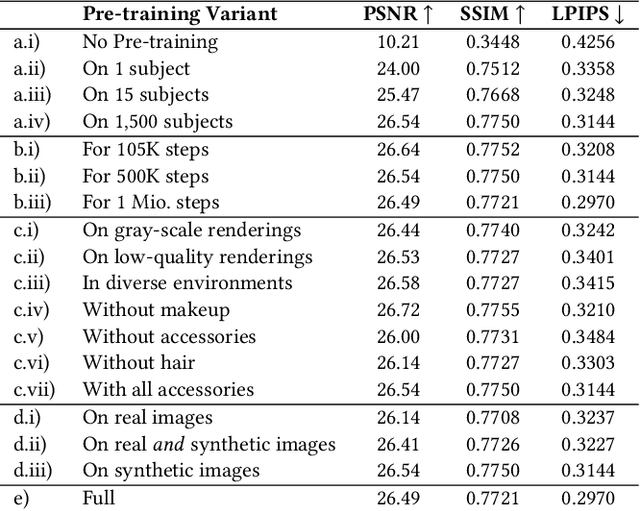
Abstract:Volumetric modeling and neural radiance field representations have revolutionized 3D face capture and photorealistic novel view synthesis. However, these methods often require hundreds of multi-view input images and are thus inapplicable to cases with less than a handful of inputs. We present a novel volumetric prior on human faces that allows for high-fidelity expressive face modeling from as few as three input views captured in the wild. Our key insight is that an implicit prior trained on synthetic data alone can generalize to extremely challenging real-world identities and expressions and render novel views with fine idiosyncratic details like wrinkles and eyelashes. We leverage a 3D Morphable Face Model to synthesize a large training set, rendering each identity with different expressions, hair, clothing, and other assets. We then train a conditional Neural Radiance Field prior on this synthetic dataset and, at inference time, fine-tune the model on a very sparse set of real images of a single subject. On average, the fine-tuning requires only three inputs to cross the synthetic-to-real domain gap. The resulting personalized 3D model reconstructs strong idiosyncratic facial expressions and outperforms the state-of-the-art in high-quality novel view synthesis of faces from sparse inputs in terms of perceptual and photo-metric quality.
EgoGaussian: Dynamic Scene Understanding from Egocentric Video with 3D Gaussian Splatting
Jun 28, 2024

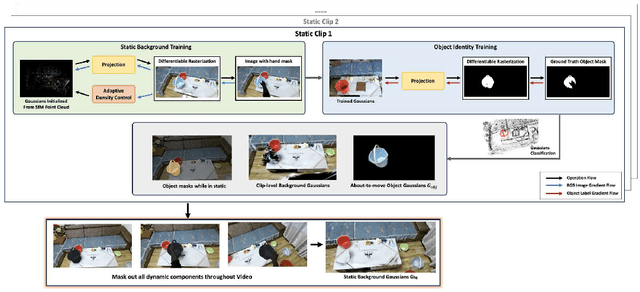

Abstract:Human activities are inherently complex, and even simple household tasks involve numerous object interactions. To better understand these activities and behaviors, it is crucial to model their dynamic interactions with the environment. The recent availability of affordable head-mounted cameras and egocentric data offers a more accessible and efficient means to understand dynamic human-object interactions in 3D environments. However, most existing methods for human activity modeling either focus on reconstructing 3D models of hand-object or human-scene interactions or on mapping 3D scenes, neglecting dynamic interactions with objects. The few existing solutions often require inputs from multiple sources, including multi-camera setups, depth-sensing cameras, or kinesthetic sensors. To this end, we introduce EgoGaussian, the first method capable of simultaneously reconstructing 3D scenes and dynamically tracking 3D object motion from RGB egocentric input alone. We leverage the uniquely discrete nature of Gaussian Splatting and segment dynamic interactions from the background. Our approach employs a clip-level online learning pipeline that leverages the dynamic nature of human activities, allowing us to reconstruct the temporal evolution of the scene in chronological order and track rigid object motion. Additionally, our method automatically segments object and background Gaussians, providing 3D representations for both static scenes and dynamic objects. EgoGaussian outperforms previous NeRF and Dynamic Gaussian methods in challenging in-the-wild videos and we also qualitatively demonstrate the high quality of the reconstructed models.
FaceFolds: Meshed Radiance Manifolds for Efficient Volumetric Rendering of Dynamic Faces
Apr 22, 2024Abstract:3D rendering of dynamic face captures is a challenging problem, and it demands improvements on several fronts$\unicode{x2014}$photorealism, efficiency, compatibility, and configurability. We present a novel representation that enables high-quality volumetric rendering of an actor's dynamic facial performances with minimal compute and memory footprint. It runs natively on commodity graphics soft- and hardware, and allows for a graceful trade-off between quality and efficiency. Our method utilizes recent advances in neural rendering, particularly learning discrete radiance manifolds to sparsely sample the scene to model volumetric effects. We achieve efficient modeling by learning a single set of manifolds for the entire dynamic sequence, while implicitly modeling appearance changes as temporal canonical texture. We export a single layered mesh and view-independent RGBA texture video that is compatible with legacy graphics renderers without additional ML integration. We demonstrate our method by rendering dynamic face captures of real actors in a game engine, at comparable photorealism to state-of-the-art neural rendering techniques at previously unseen frame rates.
Preface: A Data-driven Volumetric Prior for Few-shot Ultra High-resolution Face Synthesis
Sep 28, 2023Abstract:NeRFs have enabled highly realistic synthesis of human faces including complex appearance and reflectance effects of hair and skin. These methods typically require a large number of multi-view input images, making the process hardware intensive and cumbersome, limiting applicability to unconstrained settings. We propose a novel volumetric human face prior that enables the synthesis of ultra high-resolution novel views of subjects that are not part of the prior's training distribution. This prior model consists of an identity-conditioned NeRF, trained on a dataset of low-resolution multi-view images of diverse humans with known camera calibration. A simple sparse landmark-based 3D alignment of the training dataset allows our model to learn a smooth latent space of geometry and appearance despite a limited number of training identities. A high-quality volumetric representation of a novel subject can be obtained by model fitting to 2 or 3 camera views of arbitrary resolution. Importantly, our method requires as few as two views of casually captured images as input at inference time.
GazeNeRF: 3D-Aware Gaze Redirection with Neural Radiance Fields
Dec 08, 2022Abstract:We propose GazeNeRF, a 3D-aware method for the task of gaze redirection. Existing gaze redirection methods operate on 2D images and struggle to generate 3D consistent results. Instead, we build on the intuition that the face region and eyeballs are separate 3D structures that move in a coordinated yet independent fashion. Our method leverages recent advancements in conditional image-based neural radiance fields and proposes a two-stream architecture that predicts volumetric features for the face and eye regions separately. Rigidly transforming the eye features via a 3D rotation matrix provides fine-grained control over the desired gaze angle. The final, redirected image is then attained via differentiable volume compositing. Our experiments show that this architecture outperforms naively conditioned NeRF baselines as well as previous state-of-the-art 2D gaze redirection methods in terms of redirection accuracy and identity preservation.
EyeNeRF: A Hybrid Representation for Photorealistic Synthesis, Animation and Relighting of Human Eyes
Jun 16, 2022
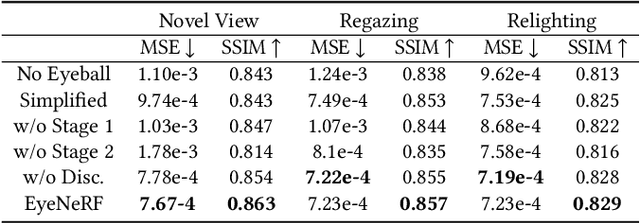
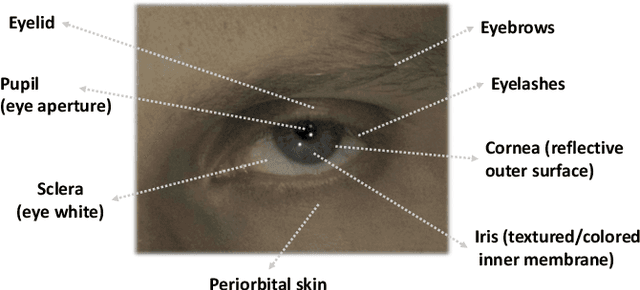
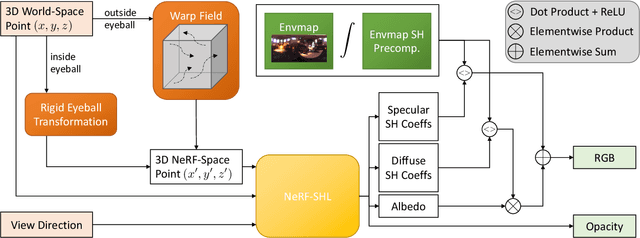
Abstract:A unique challenge in creating high-quality animatable and relightable 3D avatars of people is modeling human eyes. The challenge of synthesizing eyes is multifold as it requires 1) appropriate representations for the various components of the eye and the periocular region for coherent viewpoint synthesis, capable of representing diffuse, refractive and highly reflective surfaces, 2) disentangling skin and eye appearance from environmental illumination such that it may be rendered under novel lighting conditions, and 3) capturing eyeball motion and the deformation of the surrounding skin to enable re-gazing. These challenges have traditionally necessitated the use of expensive and cumbersome capture setups to obtain high-quality results, and even then, modeling of the eye region holistically has remained elusive. We present a novel geometry and appearance representation that enables high-fidelity capture and photorealistic animation, view synthesis and relighting of the eye region using only a sparse set of lights and cameras. Our hybrid representation combines an explicit parametric surface model for the eyeball with implicit deformable volumetric representations for the periocular region and the interior of the eye. This novel hybrid model has been designed to address the various parts of that challenging facial area - the explicit eyeball surface allows modeling refraction and high-frequency specular reflection at the cornea, whereas the implicit representation is well suited to model lower-frequency skin reflection via spherical harmonics and can represent non-surface structures such as hair or diffuse volumetric bodies, both of which are a challenge for explicit surface models. We show that for high-resolution close-ups of the eye, our model can synthesize high-fidelity animated gaze from novel views under unseen illumination conditions.
VariTex: Variational Neural Face Textures
Apr 13, 2021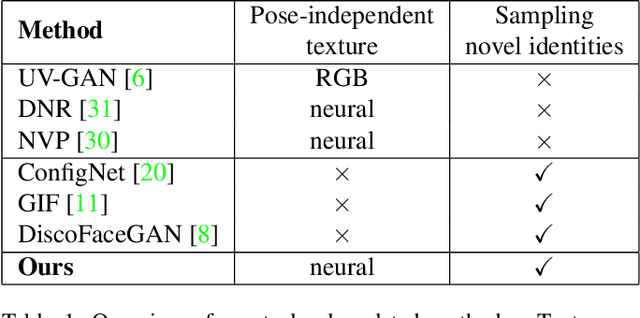
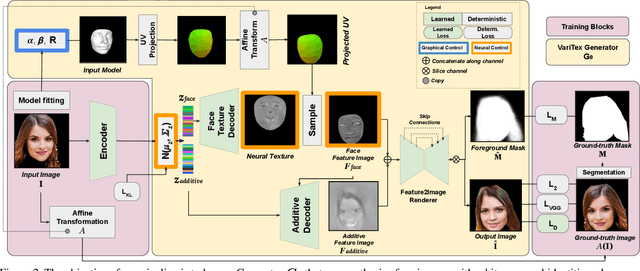

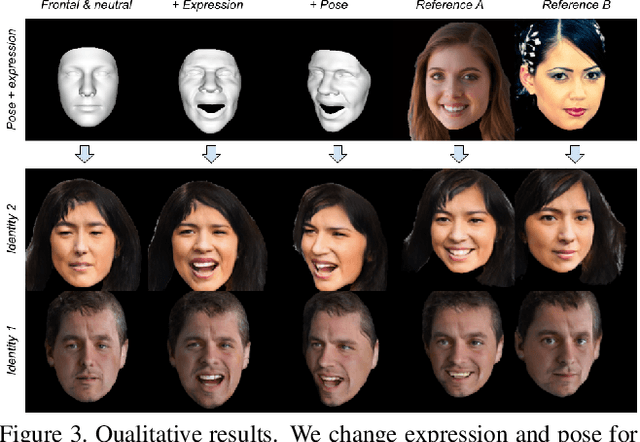
Abstract:Deep generative models have recently demonstrated the ability to synthesize photorealistic images of human faces with novel identities. A key challenge to the wide applicability of such techniques is to provide independent control over semantically meaningful parameters: appearance, head pose, face shape, and facial expressions. In this paper, we propose VariTex - to the best of our knowledge the first method that learns a variational latent feature space of neural face textures, which allows sampling of novel identities. We combine this generative model with a parametric face model and gain explicit control over head pose and facial expressions. To generate images of complete human heads, we propose an additive decoder that generates plausible additional details such as hair. A novel training scheme enforces a pose independent latent space and in consequence, allows learning of a one-to-many mapping between latent codes and pose-conditioned exterior regions. The resulting method can generate geometrically consistent images of novel identities allowing fine-grained control over head pose, face shape, and facial expressions, facilitating a broad range of downstream tasks, like sampling novel identities, re-posing, expression transfer, and more.
 Add to Chrome
Add to Chrome Add to Firefox
Add to Firefox Add to Edge
Add to Edge